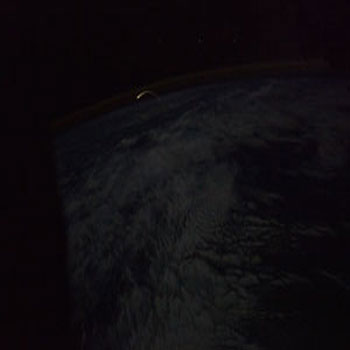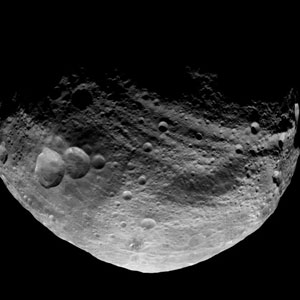Every other issue I like to walk you through some awe-inspiring views of different parts of God’s Cosmos. May these views of the heavens truly turn our gaze heavenward.

Space shuttle Atlantis re-enters the atmosphere during the Space Shuttle Program’s 135th and final flight. An astronaut on the International Space Station took this nighttime image on July 21, 2011 of the shuttle’s trail of super-heated plasma. Though the Shuttle Program is over, American astronauts will launch again from US soil in four years or so through public-private partnerships with companies like as Space Exploration Technologies. In the interim, American astronauts will launch to the space station from Russia. Image credit: NASA.

Here’s a brand-new image of Vesta, the largest asteroid and second-largest object in the Asteroid Belt (the largest being the dwarf planet Ceres). NASA’s Dawn spacecraft just pulled into orbit of this tiny world a few weeks ago and will map the surface from orbit before leaving for Ceres. Vesta may be a small world, but meteorites from it show it to have been a very geologically active little world. Can you find a snowman in the craters? Image credit: NASA/JPL/Caltech.

The Soccer Ball Planetary Nebula was only discovered in January of this year by an amateur astronomer in Austria named Matthias Kronberger. This nebula was named in his honor as Kronberger 61 (or Kn 61, for short). Even though this is called a planetary nebula, it has nothing to do with planets and is only called that because it superficially resembles a planet. The blue ball used to be the outer layers of the blue-white star you see in the middle, and this is how the Sun will appear in five billion years–as long as God allows the Universe wind-down after Christ’s return (1 Thessalonians 4:16-18). Image credit: Gemini Observatory.

NASA’s Mars rover named Opportunity, which has been roving Mars since 2004, is approaching the rim of a large crater named Endeavor. The drive has taken the better part of three years! This image from Mars’ surface was taken on Saturday, July 30th (what were you doing then?). In the hazy distance you can see the far rim of the crater. With all the exposed layers of rocks, this should be an astro-geologic gold mine! Image credit: NASA/JPL/Cornell

NASA’s Solar Dynamics Observatory has an unblinking eye fixed on the star we know best-the Sun. If your eyes could see into the ultraviolet “the kind of invisible light that gives sunburns” this is what it might look like to you. Other stars in the night sky would look similar if we had a zoom lens powerful enough. Image credit:NASA/GSFC.



